#edwin blum
Explore tagged Tumblr posts
Text
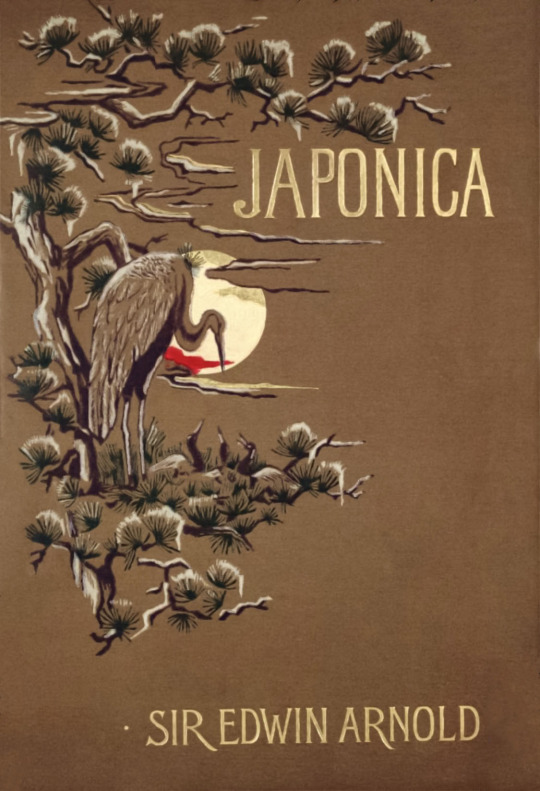
JAPONICA by Sir Edwin Arnold (New York: Scribners, 1891). Illustrated by Robert Frederick Blum.
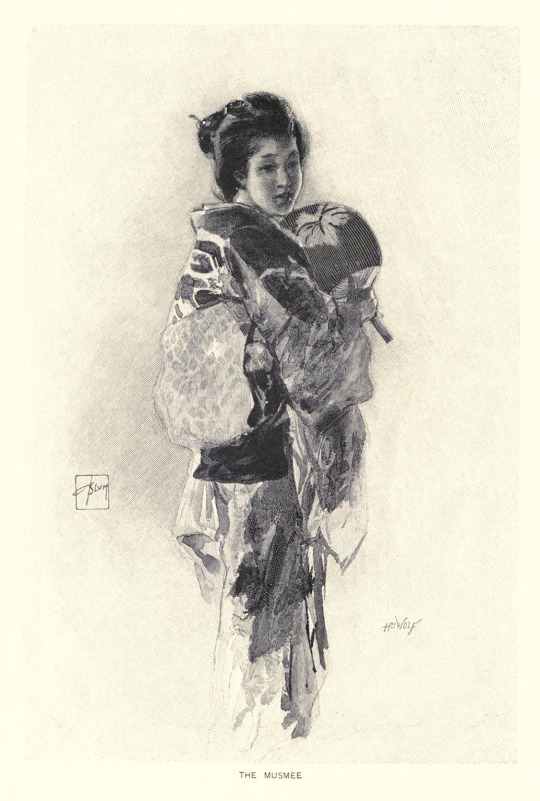
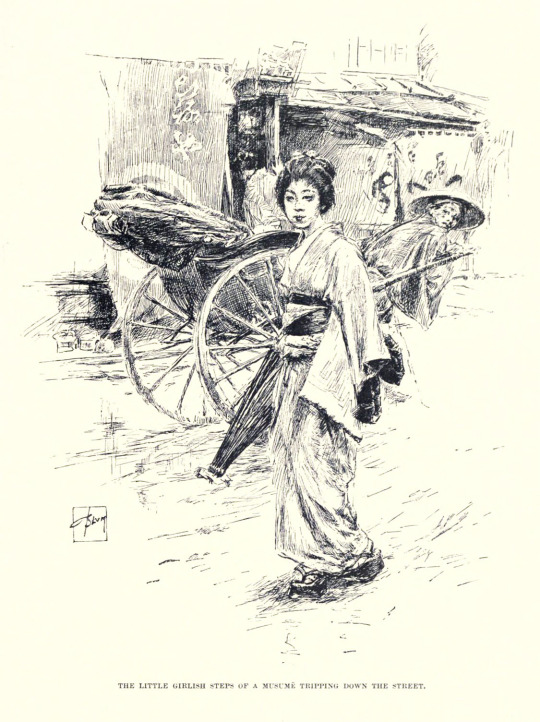
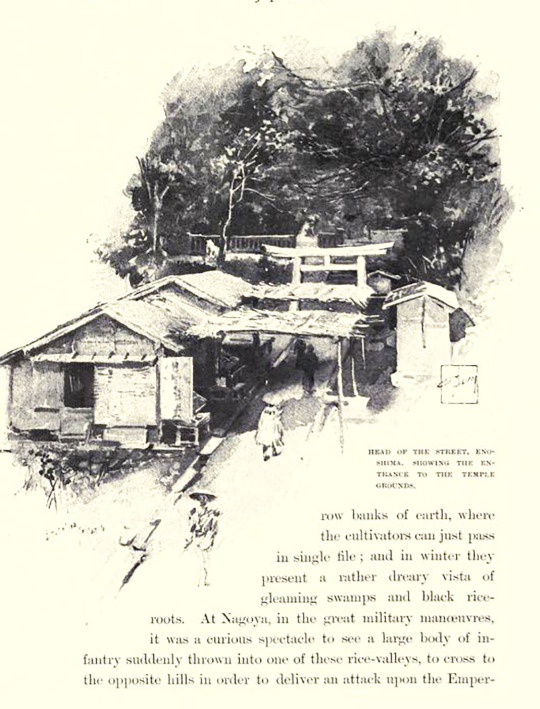
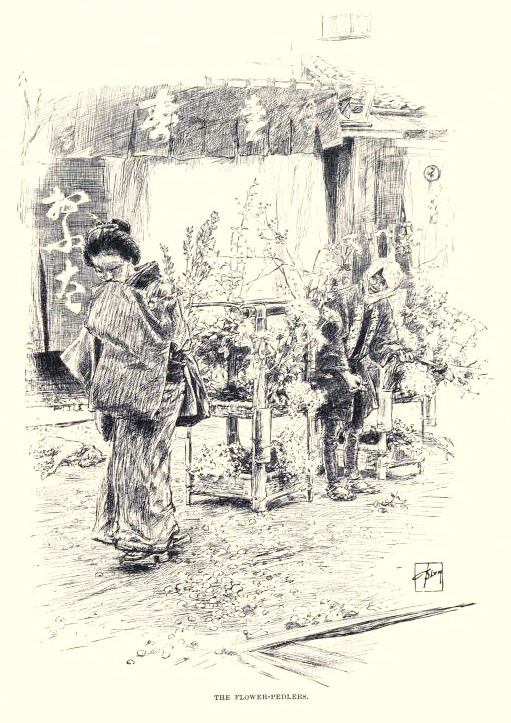
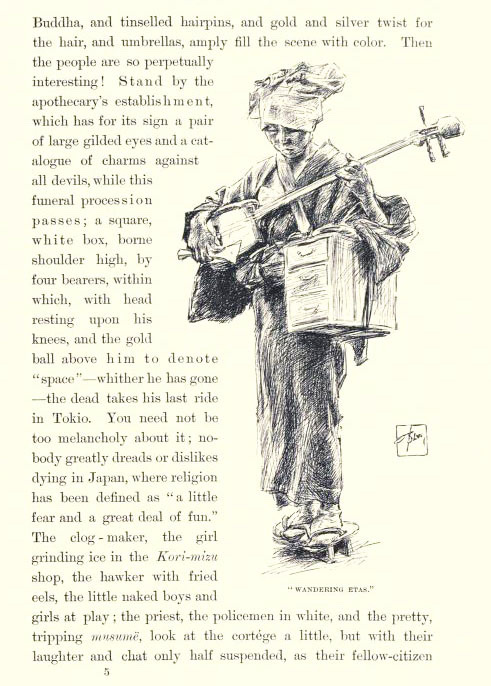
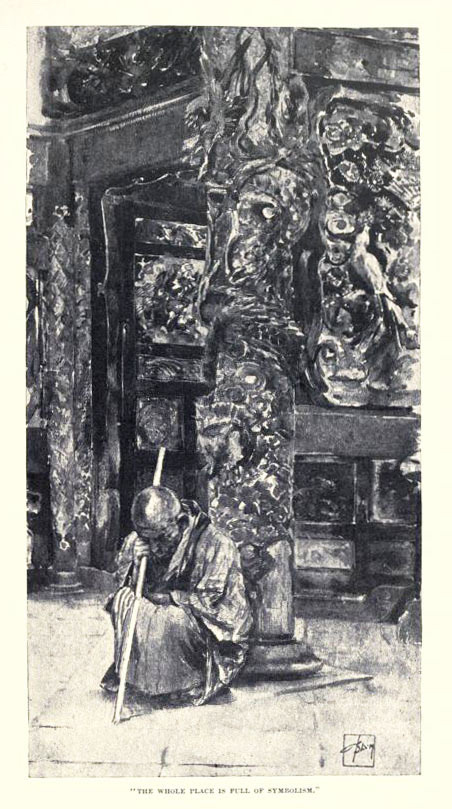
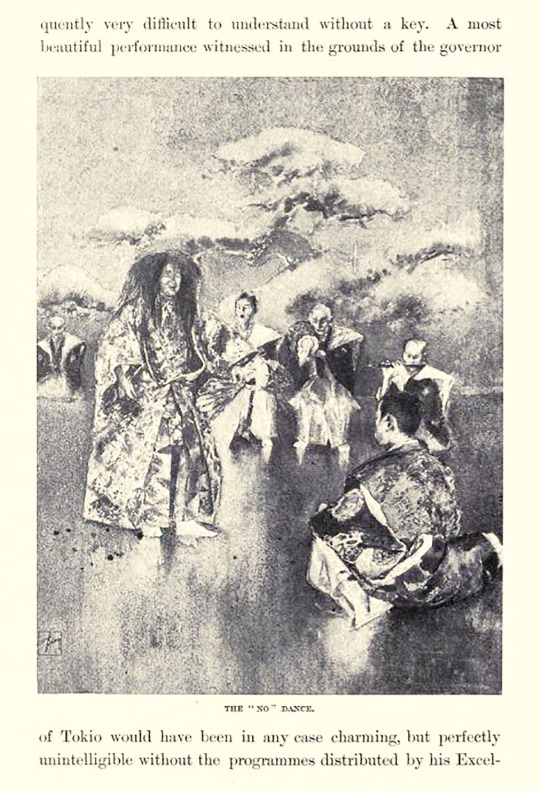
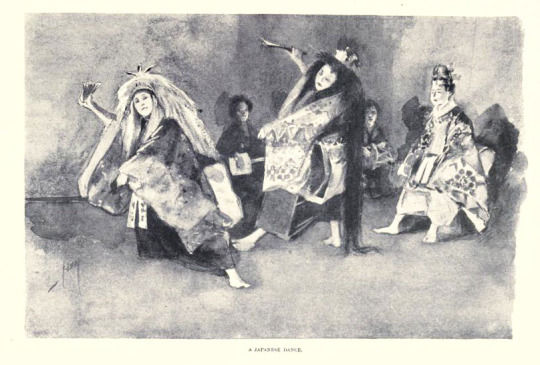
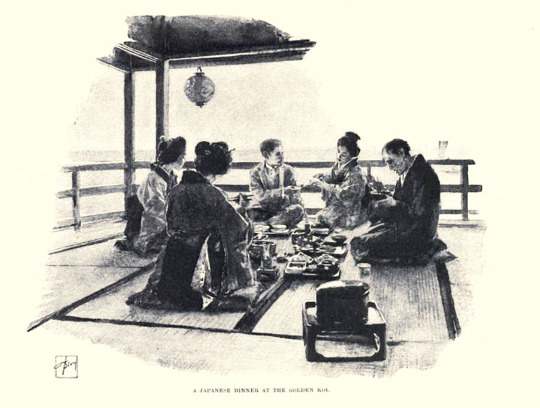
source
#beautiful books#book blog#books books books#book cover#books#vintage books#illustrated book#book design#japan#japan travel#sir edwin arnold#robert frederick blum
46 notes
·
View notes
Text
So since I'm doing “The Amazing Spider-Couple”, I've been brainstorming what the voice cast would be like if it was an animated series.
And this is what I've come up with.
The Main Couple:
-Peter Parker/Spider-Man: Josh Keaton
-Mary Jane Watson-Parker/Spinneret: Cree Summer
The Spidey Friends:
-Eddie Brock/Venom: Jake Green/Daran Norris
-Felicia Hardy/Black Cat: Jennifer Hale
-Miles Morales/Spider-Man: Nadji Jeter
-Flash Thompson/Scarlet Spider: Sam Riegel
-Curt Connors/The Lizard: Dee Bradley Baker
The Daily Bugle:
-J. Johan Jameson: J.K. Simmons
-Robbie Robertson: Phil Morris
-Betty Brant: Kath Soucie
-Ned Leeds: Jason Spisak
The Villains:
-Doctor Octopus: Rainn Wilson
-The Vulture: Dwight Schultz
-Scorpion: Daran Norris
-Sandman: Thomas F. Wilson
-Electro: Yuri Lowenthal
-The Rhino: Kevin Michael Richardson
-Kraven the Hunter: Jim Cummings
-Mysterio: Cam Clarke
-Kingpin: Jim Cummings
-Shocker: Tom Kenny
-Hydro-Man: Neil Patrick Harris
-Molten Man: Rino Romano
-White Rabbit: Hynden Walch
-The Spot: Crispin Freeman
-The Beetle: Grey Griffin
-Tombstone: Keith David
-The Prowler: Phil LaMarr
The Fantastic Four:
-Reed Richards/Mr. Fantastic: Ian James Corlett
-Susan Storm-Richards/The Invisible Woman: Jill Talley
-Johnny Storm/The Human Torch: Danny Cooksey
-Ben Grimm/The Thing: Dave Boat
-H.E.R.B.I.E.: Laura Bailey
-Alicia Masters-Grimm: Wendee Lee
-Franklin Richards: Kari Wahlgren
-Valeria Richards: Kari Wahlgren
Street-Level Heroes, Heroes for Hire and Solo Heroes:
-Jennifer Walters/She-Hulk: Cree Summer
-Matt Murdock/Daredevil: Roger Craig Smith
-Marc Spector/Moon Knight: Keith Ferguson
-Frank Castle/The Punisher: Diedrich Bader
-Luke Cage: Khary Payton
-Jessica Jones-Cage: Kate Higgins
-Danny Rand/Iron Fist: Johnny Yong Bosch
-Misty Knight: Cynthia McWilliams
-Colleen Wing: Stephanie Sheh
-Shang-Chi: Kaiji Tang
-Stephen Strange/Doctor Strange: Jeff Bennett
-Ava Ayala/White Tiger: Alanna Ubach
-Eric Brooks/Blade: Terry Crews
-Wade Wilson/Deadpool: John Kassir
-Doreen Green/Squirrel Girl: Milana Vayntrub
The Avengers and Co.:
-Steve Rogers/Captain America: Brian Bloom
-Bruce Banner/The Incredible Hulk: Joe Zieja/Fred Tatasciore
-Tony Stark/Iron Man: Nolan North
-Donald Blake/Thor: Patrick Seitz
-Natasha Romonova/The Black Widow: Vanessa Marshall
-Clint Barton/Hawkeye: Matthew Mercer
-T'Challa/The Black Panther: James C. Mathis III
-Carol Danvers/Captain Marvel: Janet Varney
-Hank Pym/Ant-Man: Ben Savage
-Janet Van Dyne-Pym/The Wasp: Colleen O'Shaughnessy
-Sam Wilson/The Falcon: Bumper Robinson
-Wanda Maximoff/The Scarlet Witch: Kate Higgins
-Pietro Maximoff/Quicksilver: James Arnold Taylor
-Simon Williams/Wonder Man: Nathan Fillion
-Greer Grant/Tigra: Grey Griffin
-Julia Carpenter/Spider-Woman: Kimberly Brooks
-James “Rhodey” Rhodes/War Machine: James C. Mathis III
-Bobbi Morse-Barton/Mockingbird: E.G. Daily
-Kamala Khan/Ms. Marvel: Kathreen Khavari
-Rikki Barnes/Bucky: Lara Jill Miller
-Humberto Lopez/Reptil: Antony Del Rio
-Edwin Jarvis: Jess Harnell
-Rick Jones: Will Friedle
-Betty Ross: Misty Lee
The X-Men:
-Charles Xavier: Alan Tudyk
-James “Logan” Howlett/Wolverine: Steve Blum
-Scott Summers/Cyclops: Ben Diskin
-Ororo Munroe/Storm: Dawnn Lewis
-Jean Grey/Phoenix: Jennifer Hale
-Henry McCoy/The Beast: Dee Bradley Baker
-Remy LeBeau/Gambit: Phil LaMarr
-Anna-Marie D’Ancanto/Rogue: Jennifer Hale
-Kurt Wagner/Nightcrawler: Yuri Lowenthal
-Piotr Rasputin/Colossus: Nolan North
-Jubilation Lee/Jubilee: Dionne Quan
-Bobby Drake/Iceman: Jason Marsden
-Angelica Jones/Firestar: Jessica DiCicco
-Kitty Pryde/Shadowcat: Kath Soucie
-Lockheed: Dee Bradley Baker
-Illyana Rasputin/Magik: Laura Bailey
-Warren Worthington III/Angel: Tress MacNeille
-Emma Frost-Summers: Candi Milo
-Alison Brie/Dazzler: Cristina Vee
-Betsy Braddock/Psylocke: Jennifer Hale
-Laura Kinney/Wolverine: Grey Griffin
-Sophia Sanduval/Chat: Mandy Moore
-Morph: J.P. Karliak
-Shiro Yoshida/Sunfire: Steven Yeun
As you can see, I wanted the cast to be a mix of old and new actors, with a good chunk of the characters being voiced by previous voices.
And in a few case, they're still being voiced by their long-time recurring VAs.
Let me know what you guys think about this casting!
#the amazing spider couple#spider man#spider man fanfiction#marvel fanfiction#the daily bugle#spider man villains#fantastic four#marvel knights#heroes for hire#the defenders#the avengers#the xmen#voice headcanons#fan cast#fan voice#fan voice cast#headcanon voices
4 notes
·
View notes
Text
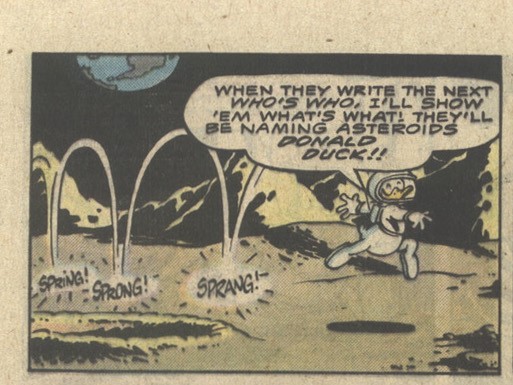
Walt Disney's Donald Duck Adventures #5: Voyage to Moonbase One
by Edwin Loftus/Geoffrey Blum; Ben Verhagen; Susan Daigle and Bill Spicer
Gladstone
17 notes
·
View notes
Photo

Stalag 17 was released in the UK on 29 May 1953, a week before its release in the US.
Billy Wilder and Edwin Blum adapted the successful Broadway play for the screen. Donald Bevan and Edmund Trzcinski wrote the play, based upon their experiences as POWs in Stalag 17B during WWII (Trzcinski appears in the film version).
The film was finished in 1952, but Paramount Pictures was reluctant to release it, believing that no one wanted to see a prisoner of war movie at the time (the Korean War was in its 3rd year), but quickly got it into theaters after the release of nearly 4,000 American POWs at the end of April and early May 1953.
The film was a commercial and critical success, and nominated for 3 Academy Awards, including Best Director (Wilder) and Best Supporting Actor (Robert Strauss, who appeared in the Broadway production. William Holden received the Best Actor Oscar (his acceptance speech is the shortest in history: “Thank you. Thank you.”).
#stalag 17#1953#1953 movies#billy wilder#edwin blum#donald bevan#edmund trzcinski#robert strauss#william holden
7 notes
·
View notes
Text








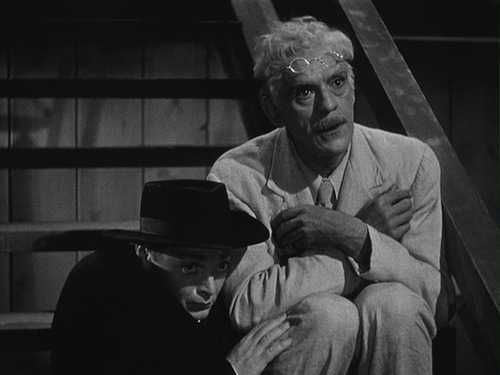

The Boogie Man Will Get You (1942)
"To think that I should be forced to reveal my secret prematurely, robbed of my triumph - and by a manufacturer of bogus hair restorer."
#the boogie man will get you#mad doctor cycle#1942#boris karloff#comedy horror film#american cinema#lew landers#edwin blum#robert b. hunt#hal fimberg#peter lorre#maxie rosenbloom#larry parks#jeff donnell#maude eburne#don beddoe#frank mitchell#george mckay#frank puglia#had high hopes for this comedy spooker; the final entry in the Karloff Mad Doctor Cycle‚ and marking the end of his contract with Columbia‚#I'd hoped for something special‚ particularly with Lorre involved. alas it's a little weak. heavily indebted to Arsenic and Old Lace#(whilst it predates Capra's film‚ the play was already a sensation and in fact Karloff had just won rave reviews playing Jonathan Brewster#on broadway) there's enough silliness and fun to keep it boiling over but it lacks the essential energy that makes screwball work.#it's nice to see Karloff playing a little against type (and the opposite of his Lace role) as the fuddery old professor whose experiments#unfortunately tend to kill their subjects; alas he's entirely upstaged by Lorre in an absolutely delightful performance as the local one#man government (mayor‚ sherrif‚ coroner‚ notary..) who inexplicably carries a kitten in his pocket at all times. it's a large and hammy#part but PL does wonders with it and steals the entire film away with him. the romantic leads are a little less noteworthy (they're fine#but couple divorced for reasons of mental cruelty just isn't as endearing as Arsenic and Old Lace's newlyweds)#silly and slight and not that impressive really‚ but Lorre truly is a delight so i guess that makes it worthwhile
21 notes
·
View notes
Photo
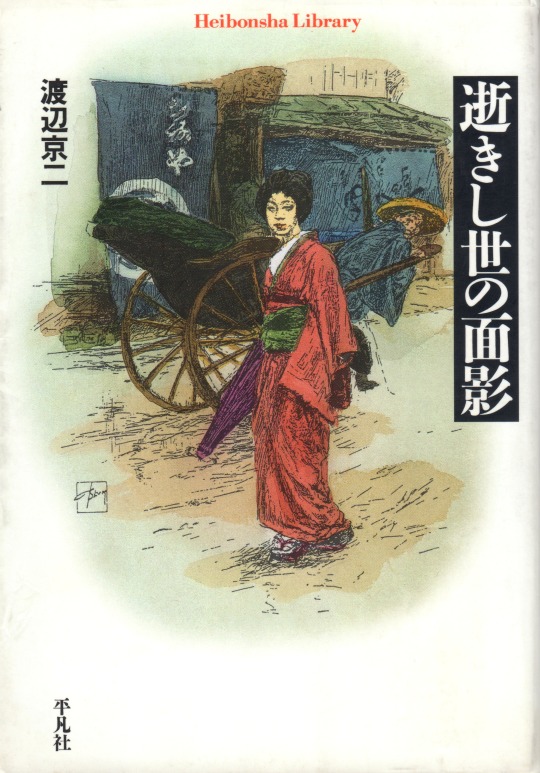
逝きし世の面影 渡辺京二 平凡社ライブラリー 552 カバー図版=「街をゆくムスメ(Arnold)」水月千春が着彩
#逝きし世の面影#kyoji watanabe#渡辺京二#平凡社ライブラリー#edwin arnold#robert frederick blum#水月千春#anamon#古本屋あなもん#あなもん#book cover
17 notes
·
View notes
Photo

Stalag 17 (1953). When two escaping American World War II prisoners are killed, the German POW camp barracks black marketeer, J.J. Sefton, is suspected of being an informer.
This is honestly a really strong film, tautly told. The visual language of it marries with a strong script and great performances to deliver one of the best war films of the year, and one of the better ones of the decade. It’s compelling from it’s first moments to it’s last, and I really, really recommend it. 8.5/10.
#stalag 17#1953#Oscars 26#Nom: Director#Nom: Actor#Won: Actor#Nom: Supporting Actor#billy wilder#edwin blum#donald bevan#Edmund Trzcinski#william holden#don taylor#Otto Preminger#robert strauss#american#america#austria#world war ii#pow#8.5/10
8 notes
·
View notes
Text
Peter Lorre in fine comedic form here in The Boogie Man Will Get You. No sound 'cause I slowed this clip down just a tad, just to indulge in the myriad of expressions and movements that man can do in mere moments.
--
I finally saw this movie - the whole movie, that is, a couple days ago. I love Lorre and Karloff is always Karloff, yet what a weird feeling to this one! I found myself wishing there had been a better plot. I still think this even as I intend to enjoy all the Lorre parts whenever I see it.
As usual, I dug into the biography to see what the deal was.
“The secret of Lorre’s indelible and unforgettable power lay, of course, in absolute innocence,” said [screenwriter] Edwin Blum. “The sweeter he smiled, the softer he spoke, the more dangerous he became. Karloff had this quality in his lisp and sweet gentleness, but Lorre faced the great master off in ‘Boogie.’”
Well, that’s nice! However:
“According to Blum, the studio had envisioned The Boogie Man Will Get You as a ‘goose pimple’ picture. At the premiere, however, audiences laughed rather than trembled.
“‘Boogie’ turned out to be a film of some minor historic meaning,” claimed Blum. "You see, nobody realized it was 'camp,' because no camp existed in those days. Lorre didn’t know it was camp, nor did Karloff. They played it absolutely straight, which is the only way camp can come off—that is, if the camp is in the writing. The reason the camp was in the writing was that I was and still am incapable of writing a straight horror film. Without knowing it, I tend to secretly kid it. There was not a single person in that company who thought they were doing anything other than another horror story. . . . this special brand of film has culminated now in Mel Brooks’ Young Frankenstein."
Huh.
I don't think two pros such as Lorre and Karloff would have mistaken this rehashing of gags and pratfalls and plot contrivances as serious or straight horror. The biographer seems to agree: "The whole idea is incomprehensible. Karloff and Lorre kidded the story themselves, salvaging an uncertain situation with mock malevolence."
Take that, Blum.
(Above excerpts from "The Lost One: A Life of Peter Lorre".)
#peter lorre#peter lorre movies#The Boogie Man Will Get You#boris karloff#horror comedy movies#at least they got paid
23 notes
·
View notes
Photo
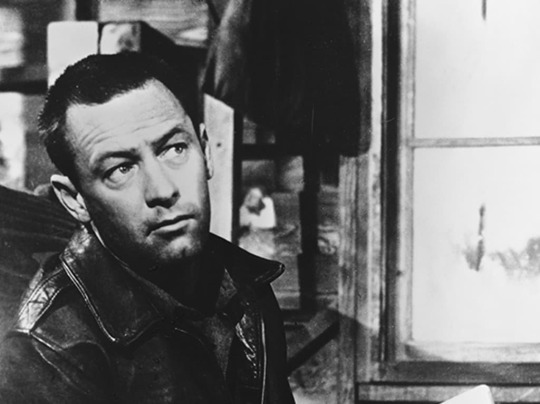
William Holden in Stalag 17 (Billy Wilder, 1953)
Cast: William Holden, Don Taylor, Otto Preminger, Robert Strauss, Harvey Lembeck, Richard Erdman, Peter Graves, Neville Brand, Sig Ruman, Edmund Trczinski,. Screenplay: Billy Wilder, Edwin Blum, based on a play by Donald Bevan and Edmund Trzcinski. Cinematography: Ernest Laszlo. Art direction: Franz Bachelin, Hal Pereira. Film editing: George Tomasini. Music: Franz Waxman.
After their success with Sunset Blvd. (1950), Billy Wilder and Charles Brackett went their separate ways. They had been one of the most successful teams in Hollywood history since 1938, when they began collaborating as screenwriters, and then as a producer (Brackett), director (Wilder), and co-writer team starting with Five Graves to Cairo in 1943. But Wilder decided that he wanted to be a triple-threat: producer, director, and writer. His first effort in this line, Ace in the Hole (1951), was, however, a commercial flop -- now regarded as a classic. So he seems to have decided to go for the sure thing: film versions of plays that had been Broadway hits and therefore had a built-in attraction to audiences. His next three movies, Stalag 17, Sabrina (1954), and The Seven Year Itch (1955), all fell into this category. But what Wilder really needed was a steady writing collaborator, which he didn't find until 1957, when he teamed up with I.A.L. Diamond for the first time on Love in the Afternoon. The collaboration hit pay dirt in 1959 with Some Like It Hot, and won Wilder his triple-threat Oscar with The Apartment (1960). Which is all to suggest that Stalag 17 appeared while Wilder was in a kind of holding pattern in his career. It's not a particularly representative work, given its origins on stage which bring certain expectations from those who saw it there and also from those who want to see a reasonable facsimile of the stage version. The play, set in a German P.O.W. camp in 1944, was written by two former inmates of the titular prison camp, Donald Bevan and Edmund Trczinski. In revising it, Wilder built up the character of the cynical Sgt. Sefton (William Holden), partly to satisfy Holden, who had walked out of the first act of the play on Broadway. Sefton is in many ways a redraft of Holden's Joe Gillis in Sunset Blvd., worldly wise and completely lacking in sentimentality, a character type that Holden would be plugged into for the rest of his career, and it won him the Oscar that he probably should have won for that film. But it's easy to see why Holden wanted the role beefed up, because Stalag 17 is the kind of play and movie that it's easy to get lost in: an ensemble with a large all-male cast, each one eager to make his mark. Harvey Lembeck and Robert Strauss, as the broad comedy Shapiro and "Animal," steal most of the scenes -- Strauss got a supporting actor nomination for the film -- and Otto Preminger as the camp commandant and Sig Ruman as the German Sgt. Schulz carry off many of the rest. The cast even includes one of the playwrights, Edmund Trczinski, as "Triz," the prisoner who gets a letter from his wife, who claims that he "won't believe it," but an infant was left on her doorstep and it looks just like her. Triz's "I believe it," which he obviously doesn't, becomes a motif through the film. Bowdlerized by the Production Code, Stalag 17 hasn't worn well, despite Holden's fine performance, and it's easy to blame it for creating the prison-camp service comedy genre, which reached its nadir in the obvious rip-off Hogan's Heroes, which ran on TV for six seasons, from 1965 to 1971.
2 notes
·
View notes
Text
Tbh I’m really glad they got someone besides Fred Tatasciore or Steve Blum to voice Waylon for once in this upcoming Injustice animated movie. And the fact that they got a young guy to play him less like a grumbly monster and probably more like the DC Rebirth version is even better. Because that’s my favorite version and I’m hoping to see it become more mainstream.
Waylon’s gonna be played by Edwin Hodge, probably best known for “The Purge” movies as Dante Bishop aka “The Stranger.” Who’s also gonna be playing Mr. Terrific as well. I’m legit stoked to hear a whole new iteration of the boi and not played by the same “go-to monster” actors.
Now I’m just hoping the scaly boi doesn’t get like one scene and then get shafted for the rest of the fucking movie. ¯\_(ツ)_/¯
Also ngl if he rocking a bit of belly like Injustice 2, I won’t complain either. 👀
6 notes
·
View notes
Photo

Join us as we take you on a tour of African Arts—Global Conversations. Curated by Kristen Windmuller-Luna and presented by Bank of America.
African Arts—Global Conversations puts African arts where they rightfully belong: within the global art historical canon. This exhibition pairs diverse African works with objects from around the world in groupings throughout the Museum.
These groupings explore how shared themes such as portraiture, faith, modernism, and origins developed independently in different parts of the globe and fill in the blanks of decades of art history teaching.
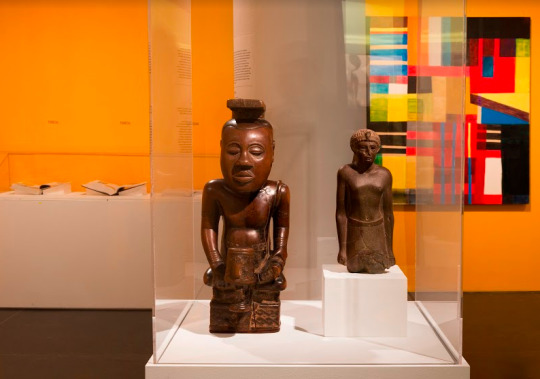
Beginning in our introductory gallery, two idealized portraits of African rulers made centuries apart greet visitors.
These portraits respect cultural norms about how a ruler is expected to look, often combining distinctive individual features with visual concepts such as divinity or rulership.

Kuba artist (Bushoong clan). Ndop figure depicting Nyim Mbó Mbóosh (reigned circa 1650), Nyim Mishé miShyááng máMbúl (reigned circa 1710), or Nyim Kot áNée (reigned circa 1740), circa 1760–80. Mushenge (Nsheng), Kasai Province, Democratic Republic of the Congo. Wood, tukula, 19 1/2 x 7 5/8 x 8 5/8 in. (49.5 x 19.4 x 21.9 cm). Purchased with funds given by Mr. and Mrs. Alastair B. Martin, Mrs. Donald M. Oenslager, Mr. and Mrs. Robert E. Blum, and the Mrs. Florence A. Blum Fund, 61.33.
Kuba ndop (commissioned royal portraits) represent the concept of leadership and contain a ruler’s life essence.The hand on this drum identifies this ruler as one of three Kuba nyim (kings): Mbó Mbóosh, Mishé miShyááng máMbúl, and Kot áNée.
Other royal indicators include his long-brimmed headdress, cowrie belt and armbands, and calm expression.

Egyptian artist. Ptolemaic Prince, 51–30 B.C.E. Egypt. Quartzite, 12 1/2 x 5 5/16 x 3 3/8 in. (31.8 x 13.5 x 8.5 cm). Charles Edwin Wilbour Fund, 54.117.
Ancient Egyptian sculptures use hieroglyphic text to identify subjects by name, but a blank back pillar suggests this sculpture is unfinished.
Although this figure is unidentified, his youth, crown, and Hellenistic hair and face suggest that he is Caesarion, son of Cleopatra VII and Julius Caesar.

Warriors hold a valued place in many societies across time and place. Warriors’ memorials reflect what societies think these figures “should” look like, often representing ideals rather than individuals.

Huastec artist. Warrior Figure, circa 1440–1521. Xico Viejo, Veracruz, Mexico. Sandstone, 65 3/16 x 14 3/4 x 7 1/2 in. (165.6 x 37.5 x 19.1 cm). Frank L. Babbott Fund, 39.371.
Wooden stelae (left/middle) memorializing powerful Konso warriors in Ethiopia were grouped with additional sculptures of weapons, slain animals, and defeated foes. The stelae memorialize specific male Konso ancestors, emphasizing his individual deeds as well as his connection to shared experiences and values.
The stone Huastec warrior figure (right) from Mexico is adorned with fearsome symbols of death such as the human skulls on his skirt and bead-and-human-heart necklace. Huastec viewers who saw these elements knew he was likely Micoatl-Camaxtle, the god of hunting and warfare.

Nestled amongst our European paintings and sculpture collection are three Ethiopian processional crosses.
Beginning in the medieval period, the Christian Ethiopian Kingdom and numerous Italian states enjoyed a lively relationship that included travel and exchange of religious art and ideas between the two regions.
Ethiopian Orthodox priests carried these copper alloy crosses atop staffs (right).
just as their Italian Catholic counterparts carried wooden ones like this (left).
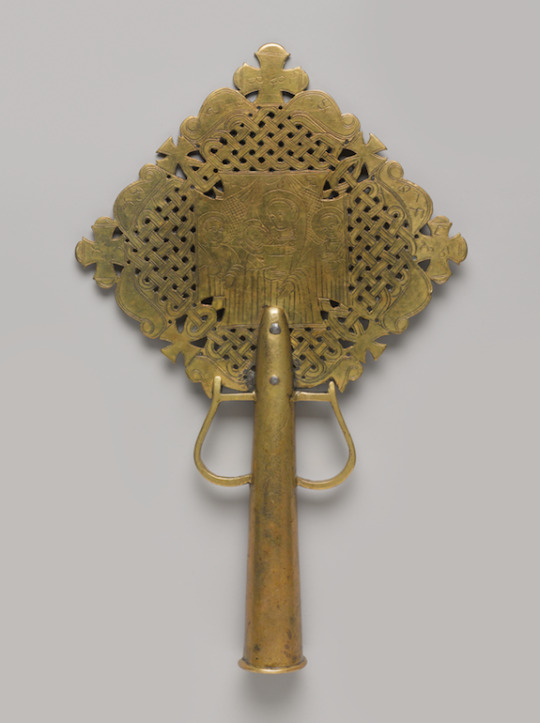
Amhara artist. Processional Cross (qäqwami mäsqäl), late 15th or early 16th century. Possibly Lalibela, Ethiopia. Copper alloy, 11 1/2 x 7 3/16 in. (29.0 x 18.3 cm). Gift of George V. Corinaldi, Jr., 81.163.2.
An Ethiopian artist incised Mary holding the Christ child, archangels, and saints on this fifteenth- or sixteenth century cross.
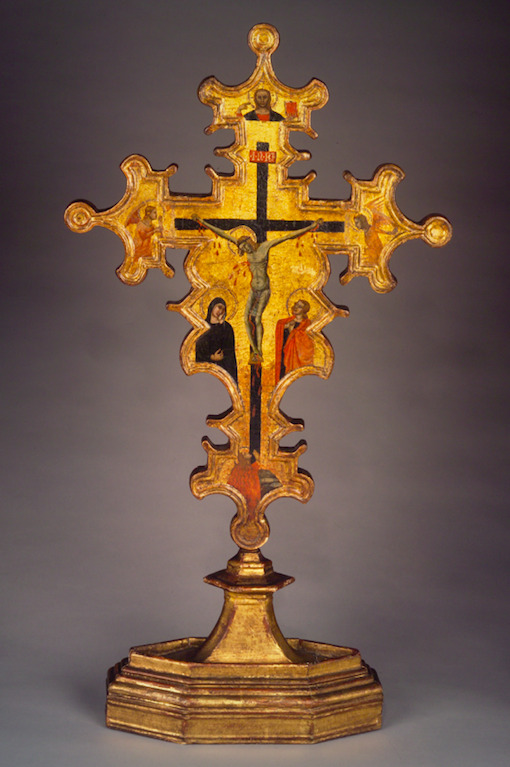
Master of Monte del Lago (Italian, School of Umbria, second quarter of the 14th century). Double-Sided Processional Cross, second quarter of the 14th century. Umbria, Italy. Tempera and gold on panel, 39 1/16 x 16 9/16 x 4 5/8 in. (99.2 x 42.1 x 11.7 cm). Gift of Mary Babbott Ladd, Lydia Babbott Stokes, and Frank L. Babbott, Jr., in memory of their father, Frank L. Babbott, 34.845.
While the Master of Monte del Lago painted Crucifixion scenes on this fourteenth-century gilded Italian cross.
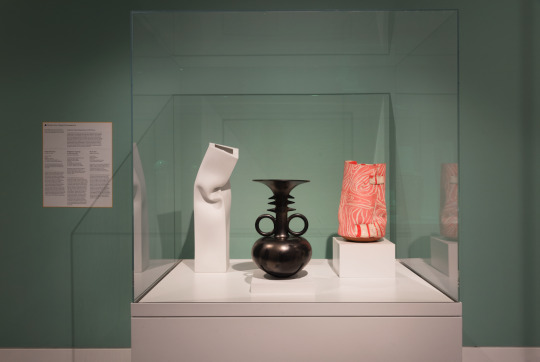
A trio of ceramics made by living artists born in Kenya, Korea, and Nigeria shows the ways that modern ceramicists can choose to draw inspiration from their own regional heritage, or not.

Magdalene Anyango N. Odundo DBE (British, born 1950, Kenya). Symmetrical Reduced Black Narrow-Necked Tall Piece, 1990. Farnham, Surrey, England. Terracotta, 16 x 10 x 10 in. (40.6 x 25.4 x 25.4 cm). Purchased with funds given by Dr. and Mrs. Sidney Clyman and the Frank L. Babbott Fund, 1991.26. © Magdalene Anyango N. Odundo
Dame Magdalene Anyango N. Odundo fires her dramatic pots multiple times to create glossy, iridescent surfaces.
Born in Kenya, she learned ceramics in Britain (where she lives today), citing pottery traditions from multiple other countries as her primary influences, drawing ideas from Nigerian Gwari ceramics, Native American Pueblo pottery, European Modernism, and even ancient Cycladic art.
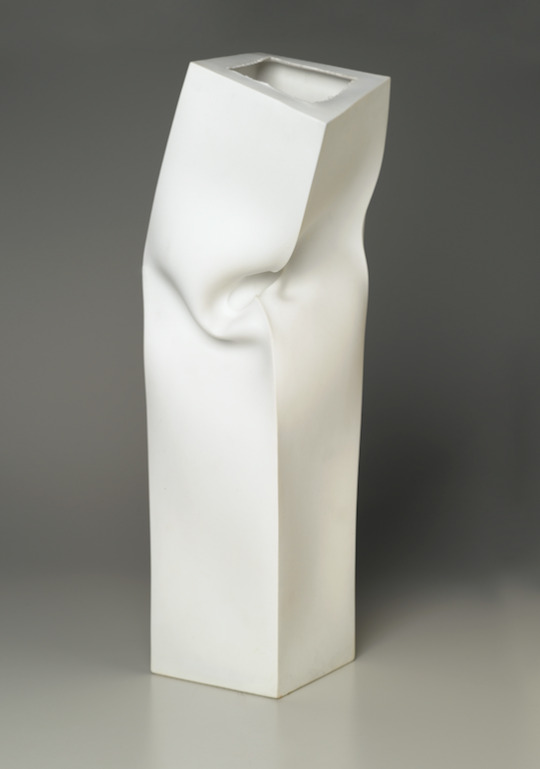
Kang Suk Young (Korean, born 1949). Untitled, 1992. Korea. Unglazed porcelain, 24 13/16 x 6 x 6 in. (63 x 15.3 x 15.3 cm). Purchased with funds given by Dr. and Mrs. Richard Dickes, 2006.20. © Kang Suk Young
Kang Suk Young uses porcelain, a medium that is traditional in his home country of Korea, but he creates forms using slip casting, a method he learned in France. He pulls the porcelain from its mold when it is still somewhat soft and twists and bends it to create something that is lively and anthropomorphic.

Ranti Bam (Nigerian, born 1982). Antafi, 2019. London, England. Terracotta, 15 3/8 × 8 1/4 × 8 1/4 in. (39 × 21 × 21 cm). Gift of Anne Goldrach in honor of Anne Pasternak, 2019.25. © Ranti Bam
Ranti Bam has created a very complex object, contrasting a heavy clay slab with delicate painting, and a rough surface with areas of shiny glaze.
The painted surface references woodgrain, but in an unlikely color of dark pink that gives the vessel its name, Antafi, a word that the artist derived from the Greek word for “rose” (triantafyllo).

Although these artists participate in the multinational field of contemporary ceramics, their work has until now been categorized by the museum according to their place of birth.
Grouping these ceramics highlights how museums (including Brooklyn!) tend to leave artists born outside of Europe and the U.S. out of conversations about contemporary art.

Kongo (Yombe subgroup) artist. Power Figure (nkisi): Woman and Child, 19th century. Lower Congo Province, Democratic Republic of the Congo. Wood, glass, upholstery studs, metal, metal and glass buttons, resin, 11 x 5 x 4 1/2 in. (27.9 x 12.7 x 11.4 cm). Museum Expedition 1922, Robert B. Woodward Memorial Fund, 22.1138.
This sculpture is linked to a Kongo fertility-focused women’s cult that flourished during the height of the Transatlantic Slave Trade. During this period, women both raised children and took on customarily male agricultural roles. Made into an nkisi (power figure), it underscores how Kongo women supported future generations during a time of widespread social upheaval and trauma.

Louis Rémy Mignot (American, 1831-1870). Niagara, 1866. Oil on canvas, 61 1/2 × 104 1/4 × 4 1/2 in. (156.2 × 264.8 × 11.4 cm). Gift of Arthur S. Fairchild, 1993.118.
Displayed in a gallery devoted to Civil War and Reconstruction-era (1861–1877) American art, this sculpture provides a poignant Central African perspective on the widespread repercussions of the Transatlantic Slave Trade.
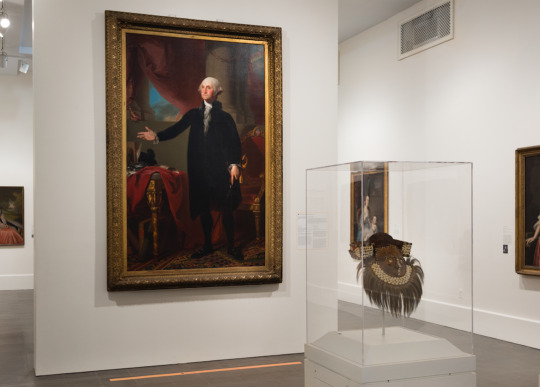
On the fifth floor, you’ll find a pairing of two great leaders: Wóót and George Washington. Artist-made images created before the invention of photography, they show how two artists represented their society’s founding fathers.

Kuba artist. Mask (Mwaash aMbooy), late 19th or early 20th century. Kasaï Province (former Kasaï-Occidental Province), Democratic Republic of the Congo. Rawhide, paint, plant fibers, textile, cowrie shells, glass, wood, monkey pelt, and feathers, 22 x 20 x 18 in. (55.9 x 50.8 x 45.7 cm). Museum Expedition 1922, Robert B. Woodward Memorial Fund, 22.1582.
The Mwaash aMbooy mask personifies Wóót, mythical ancestor of the D.R. Congo’s Kuba peoples. Kings performed this mask during initiations and funerals. One performance tells the story of Wóót’s role in the Kuba kingdom's founding and his ties to its first ruler.

Gilbert Stuart (American, 1755–1828). George Washington, 1796. Oil on canvas, 96 1/4 x 60 1/4 in. (244.5 x 153 cm). Dick S. Ramsay Fund and Museum Purchase Fund, 45.179.
Gilbert Stuart’s larger-than-lifesize portrait of George Washington reminds a young republic of the soldier who led them to victory and the statesman who stepped down from power for the country to flourish for some.
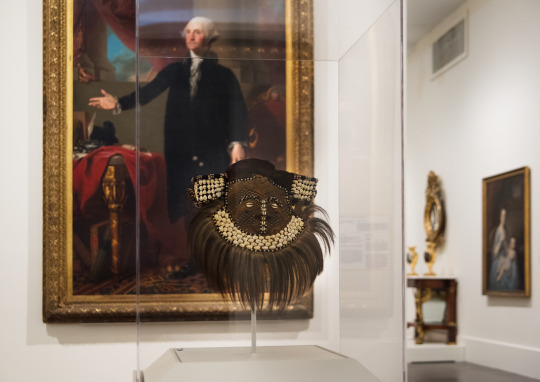
Both works rely on extensive symbolism and create enduring images of “founding fathers.”
While Stuart’s portrait turned an individual into an icon, the Kuba artist’s Wóót mask connected a current ruler to his dynastic past.

Beauford Delaney began including African artworks in a series of compositions from the 1940s as he deepened his engagement with the African American cultural movement called the Harlem Renaissance.

Beauford Delaney (American, 1901-1979). Untitled (Fang Sculpture, Crow and Fruit), 1945. Oil on canvas, 25 x 30 in. (63.5 x 76.2 cm). Brooklyn Museum, Brooklyn Museum Fund for African American Art in honor of Arnold Lehman, A. Augustus Healy Fund and Ella C. Woodward Memorial Fund, 2014.73. © artist or artist's estate (Photo: Brooklyn Museum, 2014.73_PS9.jpg)
In this dynamic and brightly colored still life, a bird of spirit figure hovers over a bowl of lemons, presenting them as an offering to Fang ancestors represented by the reliquary sculpture seen at right.

An Ntem River Valley Master. Reliquary Guardian Figure (Eyema-o-Byeri), mid-18th to mid-19th century. Wood, iron, 23 × 5 3/4 × 5 in. (58.4 × 14.6 × 12.7 cm). Brooklyn Museum, Frank L. Babbott Fund, 51.3. Creative Commons-BY (Photo: , 51.3_overall_PS9.jpg)
By showing this painting alongside its specific source and acknowledging the contributions of Fang master artists, this grouping brings to life a transatlantic cultural dialogue and exchange.

This is just a small glimpse of the works on view in this groundbreaking exhibition. Come see for yourself as soon as we reopen our galleries!

Thank you for joining us on our tour of African Arts—Global Conversations. Join us next Sunday for another tour of our galleries!
Installation views of African Arts—Global Conversations by Jonathon Dorado.
#Virtual tour#virtual#virtual programming#Brooklyn#Brooklyn Museum#arthistory#bkmafricanarts#global conversations#african art
83 notes
·
View notes
Text
Classic Movie Posters
This famous story has been adapted to screen and other media for years. Many people have played these characters but have tried to sticky closely to how the characters have been written. These are some of the early films produced during the 1940′s. These movie posters are very different to your typical poster of the modern era as they have a hand drawn quality to them. It might be an interesting concept to use this style as a theme for my product. For each of these movie posters I’ll put in the movie biography to give it a little bit of context.
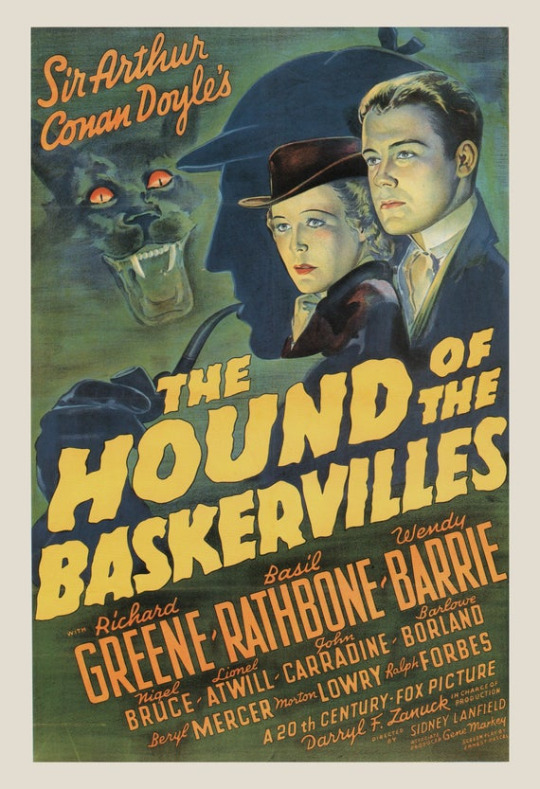
IMDb
Sherlock Holmes and Dr Watson investigate the legend of a supernatural hound, a beast that may be stalking a young heir on the fog-shrouded moorland that makes up his estate.
Director: Sidney LanfieldWriters: Ernest Pascal (screenplay), Arthur Conan Doyle (novel) (as Sir Arthur Conan Doyle)
Stars: Basil Rathbone, Nigel Bruce, Richard Greene.

IMDb
When a Nazi saboteur jeeringly predicts to the nation new depredations, via their radio 'Voice of Terror', the Intellegence Inner Council summons Sherlock Holmes (Basil Rathbone) to help in the crisis. Holmes and his companion, Dr. Watson (Nigel Bruce), are visited the first night of their investigation; a man falls dying from a knife wound on their doorstep. His last word leads Holmes into the slums where he encounters Kitty (Evelyn Ankers), the sweetheart of the slain man.
Director: John RawlinsWriters: Lynn Riggs (screenplay), John Bright (screenplay)
Stars: Basil Rathbone, Nigel Bruce, Evelyn Ankers

IMDb
The master sleuth hunts his archenemy, Professor Moriarty, who is planning the crime of the century.
Director: Alfred L. Werker (as Alfred Werker)Writers: Edwin Blum (screenplay), William Absalom Drake (screenplay) (as William Drake)
Stars: Basil Rathbone, Nigel Bruce, Ida Lupino .
IMDb is really good at finding all the films related to the series and puts them in a chronological timeline. From this you can see the evolution of movie posters from past to present. Its really sad to see how posters now are very generic with no real characteristic or personality in the design. They use very striking typography which very bold and takes up a large proportion of the poster. The combination of photographs, colours, type and drawings makes them a lot more interesting to look at. I think I would definitely consider using some of these ideas in my own project.
2 notes
·
View notes
Video
youtube
RIP Norman Gimbel, lyricist for the Wonder Woman theme.
Songwriter Norman Gimbel, whose works won him an Oscar, Grammy and admission to the Songwriters Hall of Fame, has died. He passed on Dec. 19 at his home in Montecito, Calif. at age 91, according to a tribute posted by BMI.
Gimbel’s lyrics to Roberta Flack’s Killing Me Softly and Jim Croce’s I Got A Namewere just some of the highlights of a catalog that reads like a compilation of 20th century hits. His lyrics graced the English language version of the The Girl from Ipanema and the TV themes to Happy Days and Laverne & Shirley; he earned an Academy Award with David Shire for Jennifer Warnes’s It Goes Like It Goes; he was the Best Original Song winner for 1979’s Sally Field starrer Norma Rae; and shared the Grammy Song of the Year with longtime writing collaborator Charles Fox in 1973 for Killing Me Softly.
Gimbel and Fox wrote more than 150 songs together, including the Oscar-nominated Richard’s Window (from 1975’s The Other Side of the Mountain) and Ready to Take a Chance Again (from 1978’s Foul Play).
Their TV themes also included The Paper Chase, Lifestyles of the Rich and Famous, and Wonder Woman.
Gimbel was born in Brooklyn, NY on Nov. 16, 1927. His career started in music publishing, working for David Blum and Edwin H. Morris on Teresa Brewer’s hit Ricochet Romance and Andy Williams’s 1956 hit, Canadian Sunset.
Broadway also beckoned, and he collaborated with Broadway composer Morris “Moose” Charlap on the musicals Whoop-Up in 1958 and The Conquering Hero in 1961. also working with Frank Loesser, who wrote the now-villified song Baby It’s Cold Outside.
Hollywood was next. Gimbel arrived in 1967 and immersed himself in the film and TV music world, working with composers Lalo Shifrin, Elmer Bernstein, Bill Conti, Quincy Jones, Burt Bachrach and eventually Nelly Gimbel, his daughter.
His songs graced such films as The Phantom Tollbooth (1970), Where’s Poppa? (1970), A Troll in Central Park (1994) and Lady and the Tramp 2: Scamp’s Adventure (2001).
Survivors include sons Peter and Tony, the latter who ran his publishing company, and daughters Nelly and Hannah. No memorial details have been announced.
https://deadline.com/2018/12/norman-gimbel-dies-grammy-and-oscar-winning-songwriter-for-film-tv-was-91-1202527042/

66 notes
·
View notes
Text
End of Year Book List
In the order they were read, separated by category:
Fiction
1. The Catcher in the Rye by J.D. Salinger
2. The Last Ballad by Wiley Cash
3. Z: A Novel of Zelda Fitzgerald by Therese Anne Fowler
4. Salvage the Bones by Jesmyn Ward
5. Mystic River by Dennis Lehane
6. The Martian by Andy Weir
7. Zone One by Colson Whitehead
8. The Things They Carried by Tim O’Brien
9. Anna Karenina by Leo Tolstoy
10. Jurassic Park by Michael Crichton
Nonfiction
1. Caste by Isabel Wilkerson
2. Trick Mirror by Jia Tolentino
3. Stamped from the Beginning by Ibram X. Kendi
4. Heroines by Kate Zambreno
5. The Other Side of the River by Alex Kotlowitz
6. Why Are All The Black Kids Sitting Together in the Cafeteria? 20th Anniversary Edition, by Beverly Daniel Tatum
7. The Battle of Blair Mountain by Robert Shogan
8. Female Husband by Jen Manion
9. Men We Reaped by Jesmyn Ward
10. War Against the Weak by Edwin Black
11. Work Won’t Love You Back by Sarah Jaffe
12. White Evangelical Racism by Anthea Butler
13. The World Without Us by Alan Weisman
14. The Book by Alan Watts
15. Cosmopolitanism by Kwame Anthony Appiah
16. The Origin of Others by Toni Morrison
17. Holding the Line by Barbara Kingsolver
18. Playing the Dark: Whiteness and the Literary Imagination by Toni Morrison
19. Into Thin Air by Jon Krakauer
20. On Fascism: 12 Lessons from American History by Matthew C. MacWilliams
21. The Lies that Bind by Kwame Anthony Appiah
22. The Violence of Organized Forgetting by Henry Giroux
23. The Places That Scare You by Pema Chodron
24. Under the Banner of Heaven by Jon Krakauer
25. No More Nice Girls by Lauren McKeon
26. The Honor Code: How Moral Revolutions Happen by Kwame Anthony Appiah
27. The Melancholia of Class by Cynthia Cruz
28. The Anatomy of Fascism by Robert O. Paxton
29. In Cold Blood by Truman Capote
Higher Education & Teaching
1. A Short History of Writing Instruction by James Murphy
2. Everyone Can Write by Peter Elbow
3. Beyond Education: Radical Studying for Another World by Eli Meyerhoff
4. The Anti-Racist Writing Workshop: How to Decolonize the Creative Classroom by Felicia Rose Chavez
5. Why They Can’t Write by John Warner
6. The End of Composition Studies by David Smit
7. Composing Critical Pedagogies by Amy Lee
8. Sustainable, Resilient, Free: The Future of Public Higher Education by John Warner
9. Whatever It Takes: Geoffrey Canada’s Quest to Change Harlem and America by Paul Tough
10. Ungrading by Susan Blum
11. Radical Hope: A Teaching Manifesto by Kevin Gannon
12. Broke: The Racial Consequences of Underfunding Public Universities by Kelly Nielson and Laura T. Hamilton
13. Cracks in the Ivory Tower by Jason Brennan and Philip Magness
14. The Amateur Hour: A History of College Teaching by Jonathan Zimmerman
15. The Adjunct Underclass by Herb Childress
Poetry
1. Frank: Sonnets by Diane Seuss
Total books: 55
1 note
·
View note
Text
Cooper Hewitt Short Stories: Promoting American Art
In last month’s Short Story, we attended the weddings of Hewitt sister Amy Hewitt Green and that of her daughter Eleanor Margaret Green, who became Princess Viggo of Denmark. This month, researcher Josephine Rodgers discusses the introduction of American drawing into Cooper Hewitt’s collection through the work of Robert Frederick Blum.
Margery Masinter, Trustee, Cooper Hewitt, Smithsonian Design Museum Sue Shutte, Historian at Ringwood Manor Matthew Kennedy, Publishing Associate, Cooper Hewitt, Smithsonian Design Museum
Promoting American Art
In 1903, Robert Swain Gifford, head of Cooper Union’s Woman’s Art School, declared that drawing was essential to the design process. In the Annual Report to the school’s administration, he presented the need for a permanent collection of American figure drawings to serve as models for students to develop their skills. Just a few months after Gifford wrote his plea, the Hewitt sisters helped to secure a major gift of American drawings by Robert Frederick Blum (1857–1903) to the Cooper Union Museum for the Arts of Decoration. After the artist’s tragic death at 46 of pneumonia, his sister Henrietta Haller took up the mission of securing a home for Blum’s work and promoting his legacy. In 1904, Haller donated 19 sketchbooks (with over 450 individual folios) and over 65 preparatory studies for the artist’s most esteemed Mendelssohn Glee Club mural Vintage Festival, to the Cooper Union Museum. At the time Blum was among the foremost American decorators. With this single gift, the Cooper Union Museum established itself as a repository for American art and by 1920 held major collections of drawings by Kenyon Cox, Thomas Moran, Winslow Homer, and Frederic Edwin Church.
As previous posts have discussed, Eleanor and Sarah Hewitt resolutely gathered European decorative art objects, photographs, and prints during their annual trips abroad to be studied and copied by students at Cooper Union. How did the Hewitt sisters solicit such large gifts of American art? What was their response to European modernism or the progressive American art movements in New York after 1913? Two pastel drawings, both titled Study for a seated woman, “Vintage Festival,” Mendelssohn Glee Club, New York, NY within the Cooper Hewitt collection, can help add a piece to this puzzle.
Fig 1. (left) Drawing, Study for a seated woman, “Vintage Festival,” Mendelssohn Glee Club, New York, NY, 1895–1898; Robert Frederick Blum (American, 1857–1903); Pastel crayon on wove paper; 17 3/16 × 12 1/8 in. (437 × 308 mm.); Cooper Hewitt, Smithsonian Design Museum; Gift of Henrietta Haller, 1904-16-17-b; Fig 2. (right) Drawing, Study for a seated woman, “Vintage Festival,” Mendelssohn Glee Club, New York, NY, 1895–1898; Robert Frederick Blum (American, 1857–1903); Pastel crayon on wove paper; 16 7/8 × 12 5/8 in. (429 × 320 mm.); Cooper Hewitt, Smithsonian Design Museum; Gift of Henrietta Haller, 1904-16-17-c
Fig 3. Robert F. Blum, ca. 1875, unidentified photographer, Charles Scribner’s Sons Art Reference Department records, 1839–1962, Archives of American Art, Smithsonian Institution.
To begin with, who was Robert Frederick Blum and why is his work so important to this story? Blum began his professional career in 1879 as a pen and ink illustrator for Scribner’s Magazine in New York. During a trip to Europe in 1880, he visited his former teacher Frank Duveneck in Venice and met James McNeill Whistler. Working closely with Whistler, Blum began to experiment with pastel drawings. In 1882 Blum served as President of the Society of Painters in Pastel that he co-founded with fellow American artists William Merritt Chase, James Carroll Beckwith, and Edwin Blashfield, among others. At the height of his career, in 1890, Blum was sent to Japan by Scribner’s to illustrate a series of articles by Sir Edwin Arnold. He was among the first American artists to live in Japan between 1890 and 1893. The published illustrations from his experiences helped to promote interest in Japanese culture throughout the United States. Upon his return to the New York in 1893, Blum received praise and critical attention for the pastel drawings he exhibited and sold of Japanese subjects. That same year Blum was commissioned by Alfred Corning Clark, heir to the Singer Sewing Machine fortune, to complete a series of murals for the new Mendelssohn Glee Club concert hall near Bryant Park. The Empire-style concert hall could seat more than 1,000 people and was adorned with gold finishes to embody the glamour of the Gilded Age. By 1898 Blum installed two large mural paintings, Mood to Music and Vintage Festival (each approximately 10 feet by 50 feet and including over 25 figures). The project established Blum’s reputation among the premier decorators of the American Renaissance at the turn of the twentieth century.
Emphasizing the seductive power of music without a clear narrative, the Mendelssohn Glee Club mural scheme demanded the viewer’s aesthetic imagination—moving beyond the skill of reading an image to a more intimate experience of appreciation. Attendance to the Mendelssohn Glee Club concert hall was by invitation only, but it is hard to imagine that the Hewitt sisters were not at the top of the guest list. Robert Blum’s aesthetic beliefs and remarkable talent as a draftsman were the talk of town in certain circles. He painted the Vintage Festival mural on canvas in his studio on Grove Street in Greenwich Village between 1895 and 1898. Unable to unroll the entire canvas at one time, he developed an elaborate process of transcribing ideas and figure studies through sequential series of individual drawings. This process was discussed by Royal Cortissoz in The Century Magazine as early as 1899. Today, however, it is possible for the first time to arrange the drawings to reveal the gradual developments Blum made through each iteration of the mural. [1]
Fig. 4. Robert Frederick Blum (1857–1903), Vintage Festival (Detail), mid-1895–1898; Mural panel painting; 292 x 1463 cm (114 15/16 x 576 in.); Brooklyn Museum, Gift of Edward Severin Clark, Frederick Ambrose Clark, Robert Sterling Clark, and Stephen Carlton Clark, 26.151
Fig. 5. Robert Frederick Blum (1857–1903), Vintage Festival, mid-1895–1898; Mural panel painting; 292 x 1463 cm (114 15/16 x 576 in.); Brooklyn Museum, Gift of Edward Severin Clark, Frederick Ambrose Clark, Robert Sterling Clark, and Stephen Carlton Clark, 26.151
A cataloging card from the Cooper Union Museum lists the earliest description of the 1904 gift as: 64 preparatory studies for the Vintage Festival mural and “two studies in oils, Japanese figures” (Fig. 6). New research makes it possible to identify the studies in oil to be the Study for a seated woman pastel drawings (Figs. 1–2). The drawings are figure studies in preparation for the Vintage Festival mural, representing the intoxicating power of music, instead of Japanese women (Figs. 4–5). The confusion of the subject matter can be related to a note Eleanor Hewitt wrote in 1913 when the drawings were on display at the Hewitt home 9 Lexington Avenue (Fig. 7). Given the artist’s background, it is easy to imagine a collector assigning a Japanese attribution without the comparison to the final mural. The Mendelssohn Glee Club murals were dismantled after the building was torn down in 1911. Blum was famous for his paintings of Japanese subjects and used multiple techniques in pastel that resemble the application of oil paint. Regardless of subject or media, one can imagine Eleanor and Sarah enjoying the beauty and graceful modulation of tones throughout the Study for a seated woman pastel drawings.
Fig. 6. Cataloguing Card, Department of Drawings, Prints & Graphic Design, Cooper Hewitt, Smithsonian Design Museum; Photo © Smithsonian Institution
By 1913 the Study for a seated woman drawings were on display at 9 Lexington Avenue and integrated into the interior design of the Hewitt’s home. Eleanor’s note in response to art dealer Martin Birnbaum makes it possible to gain a glimpse of how the Hewitt sisters participated in the development of American art in New York during one of its most volatile periods. In February 1913 Birnbaum organized the first retrospective of Robert Blum’s work, a decade after the artist’s death, at the Berlin Photograph Company on Madison Avenue. Over 130 paintings, watercolors, pastels, and etchings were lent to the exhibition by thirty-eight institutions and private collectors, including two of Alfred Corning Clark’s sons and Eleanor Hewitt. On January 27, 1913 Birnbaum wrote Eleanor to thank her for lending “two studies in oil” for the memorial exhibition. He inquired about the titles and whether to credit “Miss Eleanor Hewitt” or the “Misses Hewitts” in the catalog. In response on January 29, 1913 Eleanor wrote a note to Miss Gibson to take down the two sketches by Robert Blum that hung “on the round stairs half way down to the floor below.” In the note Eleanor refers to the subject of the drawings as “Japanese models” and in the exhibition catalog the titles are listed as: “Two paintings of Japanese Women.” This description has remained in the cataloging files ever since.
Fig. 7. Registrar Property Files, Cooper Hewitt, Smithsonian Design Museum; Photo © Smithsonian Institution
Displaying the Study for a seated woman pastel drawings at 9 Lexington Avenue allowed visitors to appreciate the talent of an American artist among the Hewitt’s European masterpieces. The decision to lend the drawings to the memorial exhibition was an act of support for building Blum’s legacy within the history of American art. The Memorial Loan Exhibition of The Works of Robert Frederick Blum opened days before the International Exhibition of Modern Art. Only a few blocks away at the 69th Regiment Armory on Lexington Avenue, the modern art exhibition (referred to as the Armory Show) was the first major installation of European modern art in New York. Many of Blum’s paintings and drawings were also on view for the first time; however, the memorial exhibition could not compete with the sensation that was sparked by the press when images of Marcel Duchamp’s paintings on display at the Armory Show were printed. In comparison, Blum’s work was dismissed by art critics as products from the last century instead of the modern era. In 1913 it is clear that for Eleanor and Sarah Hewitt, Blum’s drawings appealed more to their aesthetic taste and better served the didactic function of drawing for their museum than the bold and abrasive colors of modern art.
Dr. Josephine Rodgers is the Research Assistant for American Art in the Drawings, Prints & Graphic Design Department at Cooper Hewitt, Smithsonian Design Museum.
Footnotes
[1] Royal Cortissoz, “The Making of A Mural Decoration: Mr. Robert Blum’s Painting for the Mendelssohn Glee Club,” The Century Magazine (November 1899): 61.
from Cooper Hewitt, Smithsonian Design Museum https://ift.tt/2Ie2p8i via IFTTT
1 note
·
View note
Text

Shepherd's Notes: Revelation - Edwin Blum http://dlvr.it/R76vqY http://dlvr.it/R76vqY
0 notes